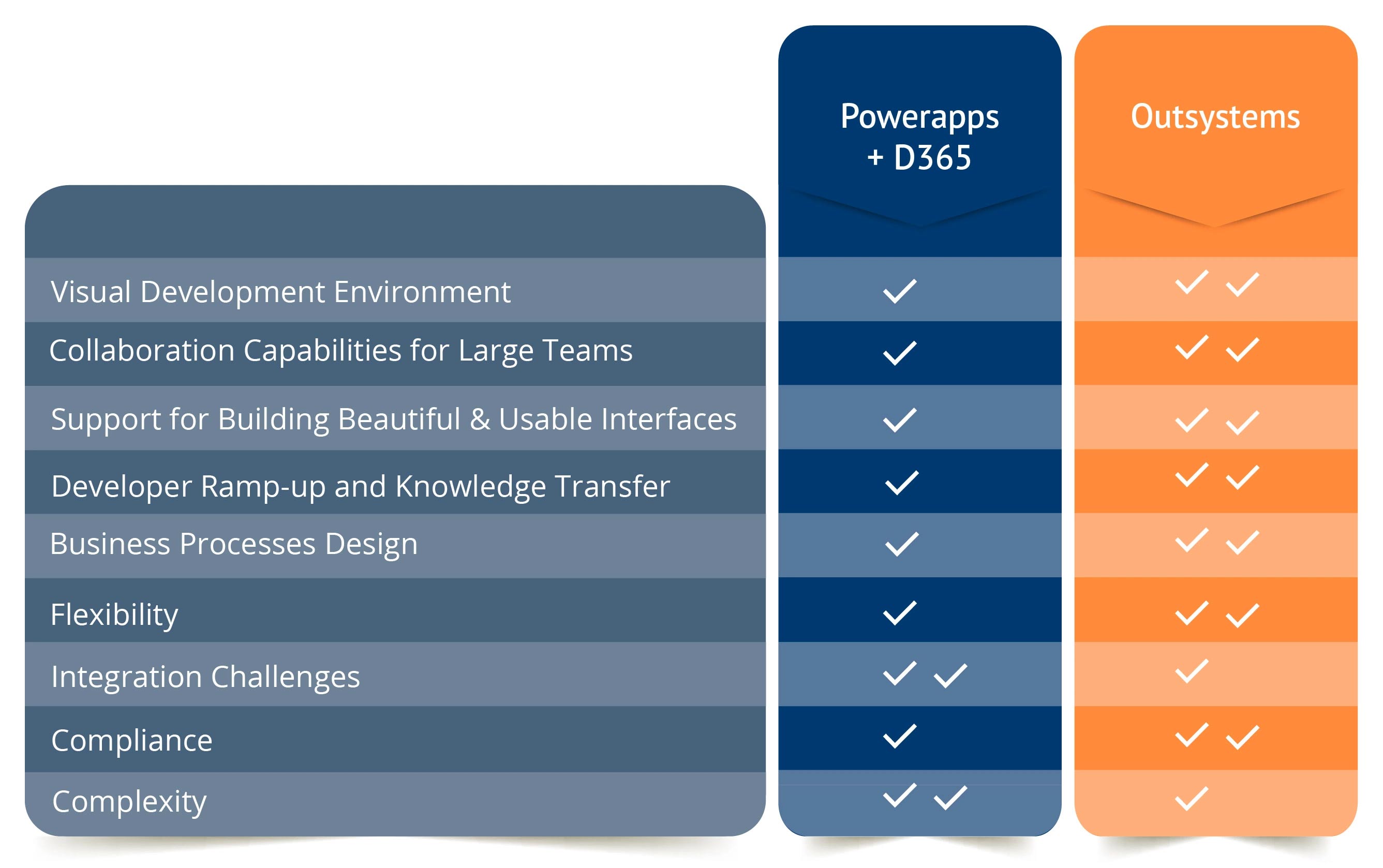Table of Contents
PowerApps vs OutSystems: Unveiling the Ultimate Development Duel
In the ever-evolving digital landscape, companies must meticulously select the application development platform to spearhead their digital transformation journey. The decision between PowerApps vs OutSystems is pivotal, given the increasing demand for agile, scalable, and innovative solutions. While both platforms offer rapid application development, their approaches and strengths differ significantly. This comparison explores the core functionalities, architectural capabilities, integration prowess, and overall suitability of PowerApps vs OutSystems, aiding businesses in selecting the platform that best fits their development needs and strategic goals.
Bringing years of specialized OutSystems experience to the forefront, DBiz.ai guarantees seamless integration and peak performance for your digital initiatives.

BEST LOW CODE DEVELOPMENT PLATFORMS: POWERAPPS VS OUTSYSTEMS

Both platforms cater to the creation of complex applications, offering tools for building custom solutions and integrating with common data services. However, their approaches differ, while PowerApps provides a seamless experience for full-stack developers familiar with the Microsoft ecosystem, OutSystems offers a robust development process suitable for diverse teams. Both platforms feature intuitive drag-and-drop interfaces, making app development accessible to a wide range of users. However, OutSystems stands out with its user-friendly interfaces, enabling developers to create sophisticated applications with ease.
As part of our ongoing mission to better inform our clients and partners, we are here to discuss the best low-code development platforms alongside the pros and cons associated with each one of them.
POWERAPPS + D365
PROS:
PowerApps integration with dynamics 365 allows users to build custom application using PowerApps and seamlessly connect them with data and processes within the Dynamics 365 ecosystem, enabling organisations to extend the functionality of their Dynamics 365 solutions and tailor them to their specific business needs.
- 1. Microsoft integration services: Seamlessly integrates with other Microsoft products and services, streamlining workflow and enhancing collaboration within the Microsoft ecosystem.
- 2. Familiarity: Leverages familiar Microsoft technologies, making it easier for organizations already using Microsoft products to adopt and implement PowerApps + D365.
- 3. Customization: Provides extensive customization options, allowing businesses to tailor applications to their specific needs without extensive coding knowledge.
- 4. Unified Platform: Offers a unified platform for building, managing, and analysing applications, reducing complexity, and enhancing productivity.
- 5. Scalability: Scales effortlessly to accommodate growing business needs, ensuring that applications can evolve along with the organization.
CONS:
- 1. Limited Integration Options: PowerApps+D365 may have constraints in integrating with diverse systems, databases, and external services due to its predefined connectors and limited customization options. This can restrict organizations from building comprehensive solutions that require seamless integration with various data sources and applications.
- 2. Monolithic vs. Microservices Architecture: PowerApps+D365 applications may adhere to a monolithic architecture, where functionalities are tightly coupled and difficult to scale or modify independently. This lack of modularity can impede agility and hinder the adoption of modern architectural principles such as microservices.
- 3. Dependency Management Challenges: PowerApps+D365 may lack robust tools for managing dependencies between different modules or components within an application. This can lead to difficulties in version control, impact analysis, and maintaining consistency across the development environment, especially in large-scale projects.
- 4. Limited Customization: PowerApps+D365's architecture may impose restrictions on customization capabilities, making it challenging to implement complex business logic, data structures, or user interfaces. This limitation can hinder organizations from building tailored solutions that meet specific business requirements effectively.
- 5. Performance and Scalability: As applications built on PowerApps+D365 grow in complexity and scale, they may encounter performance and scalability issues due to architectural constraints or limitations in resource allocation. This can impact application responsiveness, reliability, and user experience, especially under high loads or data volumes.
OUTSYSTEMS
PROS:
OutSystems shines in its comprehensive development environment, offering high productivity through visual development, impact analysis, and rapid change capabilities.
Development Capabilities:

- 1. High Productivity Development: OutSystems offers visual development with impact analysis for fast, low-risk changes and a seamless cycle for high productivity and rapid time-to-market.
- 2. Collaboration: OutSystems version control empowers large teams with advanced collaboration tools designed specifically for managing modules and applications. Developer-friendly features such as sandbox environments and visual conflict detection enhance efficiency and mitigate risks.
- 3. Interface Design: OutSystems delivers a modern look and feel with pre-built themes and layouts, plus best-in-class UI patterns for web and mobile, all easily reusable.
- 4. Developer Ramp-Up: OutSystems intuitive visual language fosters rapid tech adoption and collaboration, boosting scalability, streamlining maintenance, and cutting training costs.
- 5. Business Processes: OutSystems empowers business users and developers with a visual, all-in-one solution for designing, executing, monitoring, and optimizing business processes, streamlining workflows, and boosting supply chain efficiency.
Architecture And Integration Capabilities:
- 1. Flexible Integration: OutSystems simplifies web service consumption and exposure, alongside seamless integration with SQL Server and databases, offering optimized access and performance monitoring. Developers can create custom integration components using .NET logic, while the OutSystems Forge provides various pre-built integration components for platforms like Salesforce, DB2, Microsoft Exchange, D365, Twitter, and more.
- 2. Modular Architectures: OutSystems promotes well-behaved solution architectures with service-oriented connectivity.
- 3. Microservices: OutSystems microservices allows building decoupled architectures following microservices principles.
- 4. No Technology Lock-In: OutSystems applications run on standard stacks, ensuring no vendor lock-in.
Mobile Development Capabilities:

- 1. Native Mobile Applications: OutSystems enables visually intuitive development and deployment of attractive native iOS and Android apps, functioning offline and accessing device features like camera and GPS. Seamlessly publishable to app stores or distributed internally via MDM or MAM tools.
- 2. Design Capabilities: OutSystems provides a robust visual web design for crafting customizable UIs across various devices, backed by responsive design support. Leveraging OutSystems UI, developers access a wealth of reusable patterns for web and mobile apps, alongside full flexibility to integrate custom HTML5/JavaScript/CSS components seamlessly.
Deployment Capabilities:
- 1. Automated Deployment: OutSystems streamlines deployment with a 1-click staging process, ensuring seamless transition of applications across environments while conducting thorough impact analysis. With robust control points and detailed logging, this feature guarantees risk-free deployments for both web and mobile apps. Additionally, it simplifies mobile app generation, providing a complete package for submission to app stores with just one click, enhancing efficiency and accelerating time-to-market.
- 2. Deployment Options: OutSystems supports deployment in public cloud, private cloud, or on-premises infrastructures.
- 3. Cloud Elasticity: OutSystems excels in scalability, offering robust architecture supporting vertical and horizontal scaling. Through its management console, it enables automatic provisioning of new front-end servers and environments in its cloud infrastructure, ensuring optimal performance and adaptability to evolving business needs.
Enterprise Grade Capabilities:

- 1. OutSystems extensibility configurations: OutSystems allows extending built-in capabilities with custom code and APIs.
- 2. Security Governance: OutSystems includes integrated security governance, operations, auditing, and troubleshooting capabilities.
- 3. OutSystems performance monitoring: OutSystems offers built-in performance monitoring and troubleshooting tools.
- 4. Standard Stacks: OutSystems deploys applications on standard technology stacks for robustness and scalability.
- 5. OutSystems Enterprise Grade Security: OutSystems ensures robust security frameworks with validation against OWASP vulnerabilities.
- 6. High-Productivity Confirmation: OutSystems teams are certified to be 10.9x more productive than the industry average.
CONS:
- 1. One potential downside of the OutSystems low-code development platform is its steeper initial learning curve compared to some other platforms, necessitating users to dedicate time to master its features and functionalities.
- 2. Additionally, the platform may have limitations in highly specialized or niche development scenarios, where custom coding or integrations beyond its capabilities are necessary.
So, which do you think is the Best Low-Code Development Platform?
Now that you have reviewed the pros and cons of OutSystems and PowerApps+ D365; as you can see, the best system for you is the one that best fits the needs of your projects and business. Whether you're exploring the potential of PowerApps or OutSystems digital transformation service provider for your business, Dbiz.ai can assist you.
Explore other articles:


